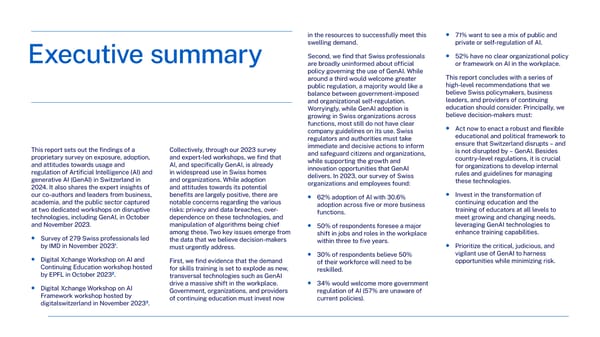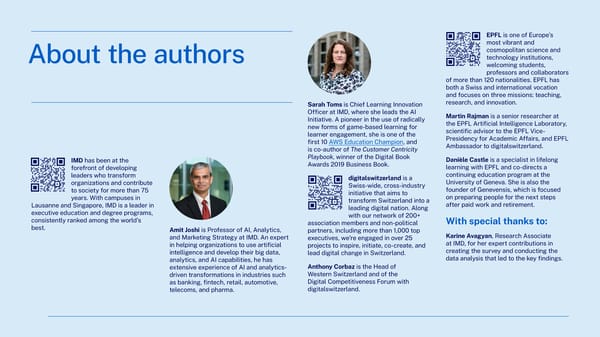Charting the future: Switzerland's path to generative AI leadership in 2024
This report sets out the findings of a proprietary survey on exposure, adoption, and attitudes towards usage and regulation of Artificial Intelligence (AI) and generative AI (GenAI) in Switzerland in 2024.
Charting the Future: Switzerland’s Path to Generative AI Leadership in 2024 and Beyond
Contents 03 Executive summary 19 4. Greater regulation is a priority and should 06 AI in Switzerland: be jointly enacted by the government and Where we are today the private sector. More than half of Swiss organizations still have no clear policy on AI 07 1. AI is already widely adopted in Switzerland, 21 Regulators must act swiftly and decisively despite concerns about its risks 09 Is there a ‘trust gap’ on AI in Switzerland? 21 Meanwhile, organizations must not wait to create their own guidelines 10 2. Swiss professionals foresee clear 22 Generative AI in Switzerland: opportunities and bene昀椀ts, but remain wary Where we want to be tomorrow of risks to privacy, over-reliance, and data manipulation 24 Recommendations for Swiss policymakers 10 How do we navigate risks to harness 24 Recommendations for Swiss providers of opportunities? continuing education 15 3. AI will reshape the jobs and roles of the future 25 Recommendations for Swiss organizations –as such, there will be a massive need to upskill 26 About the authors Swiss workers in the next 3-5 years 19 GenAI-enabled continuing education for a 27 Endnotes GenAI-enabled future? Proceed with caution
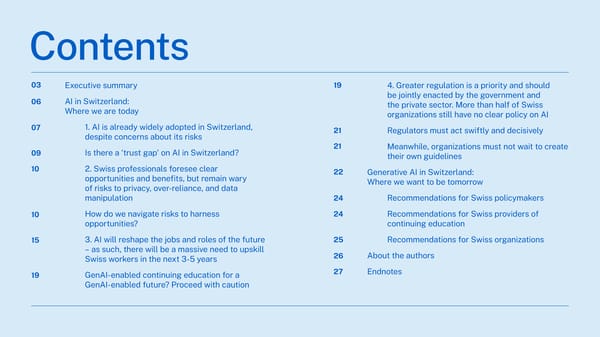
Executive summary
in the resources to successfully meet this • 71% want to see a mix of public and swelling demand. private or self-regulation of AI. Executive summary Second, we 昀椀nd that Swiss professionals • 52% have no clear organizational policy are broadly uninformed about of昀椀cial or framework on AI in the workplace. policy governing the use of GenAI. While around a third would welcome greater This report concludes with a series of public regulation, a majority would like a high-level recommendations that we balance between government-imposed believe Swiss policymakers, business and organizational self-regulation. leaders, and providers of continuing Worryingly, while GenAI adoption is education should consider. Principally, we growing in Swiss organizations across believe decision-makers must: functions, most still do not have clear company guidelines on its use. Swiss • Act now to enact a robust and 昀氀exible regulators and authorities must take educational and political framework to immediate and decisive actions to inform ensure that Switzerland disrupts – and This report sets out the 昀椀ndings of a Collectively, through our 2023 survey and safeguard citizens and organizations, is not disrupted by – GenAI. Besides proprietary survey on exposure, adoption, and expert-led workshops, we 昀椀nd that while supporting the growth and country-level regulations, it is crucial and attitudes towards usage and AI, and speci昀椀cally GenAI, is already innovation opportunities that GenAI for organizations to develop internal regulation of Arti昀椀cial Intelligence (AI) and in widespread use in Swiss homes delivers. In 2023, our survey of Swiss rules and guidelines for managing generative AI (GenAI) in Switzerland in and organizations. While adoption organizations and employees found: these technologies. 2024. It also shares the expert insights of and attitudes towards its potential our co-authors and leaders from business, bene昀椀ts are largely positive, there are • 62% adoption of AI with 30.6% • Invest in the transformation of academia, and the public sector captured notable concerns regarding the various continuing education and the at two dedicated workshops on disruptive risks: privacy and data breaches, over- adoption across 昀椀ve or more business training of educators at all levels to technologies, including GenAI, in October dependence on these technologies, and functions. meet growing and changing needs, and November 2023. manipulation of algorithms being chief • 50% of respondents foresee a major leveraging GenAI technologies to among these. Two key issues emerge from shift in jobs and roles in the workplace enhance training capabilities. • Survey of 279 Swiss professionals led the data that we believe decision-makers 1 within three to 昀椀ve years. by IMD in November 2023. must urgently address. • Prioritize the critical, judicious, and • 30% of respondents believe 50% vigilant use of GenAI to harness • Digital Xchange Workshop on AI and First, we 昀椀nd evidence that the demand of their workforce will need to be opportunities while minimizing risk. Continuing Education workshop hosted for skills training is set to explode as new, reskilled. 2 by EPFL in October 2023 . transversal technologies such as GenAI • Digital Xchange Workshop on AI drive a massive shift in the workplace. • 34% would welcome more government Framework workshop hosted by Government, organizations, and providers regulation of AI (57% are unaware of 3 of continuing education must invest now current policies). digitalswitzerland in November 2023 .
Generative AI: a 7% (or almost $7tn) increase in global the global context will be contingent on 6 An opportunity for Swiss GDP over a 10-year period . Yet even as leveraging the opportunities presented industry welcomes the potential of GenAI, by GenAI while navigating the risks and innovation, growth and there is broad consternation about its regulatory complexities. Sustaining growth competitive advantage. concomitant risks. These risks include is one thing but leveraging innovation to breaches of data privacy, manipulation of secure competitive advantage will mean data, and uncertainty around the impact carefully balancing being fast and decisive As we go into 2024, generative AI (GenAI) of intelligent automation on jobs. There with being ethical and safe. If Switzerland has captured the attention and the is also concern around the multitudes of seeks to disrupt – and avoid being imagination of organizations worldwide. biases in the alogithms translating into disrupted by GenAI – key questions must Spearheading the shift from cataloguing suboptimal or discriminatory outcomes, as be answered: to creating data is next-generation well as hallucinations – false or inaccurate AI:; transformer-based deep neural information presented as fact. Then there’s • What are the skills and capabilities network tools that are revolutionizing the speed of innovation itself. required by Swiss organizations how human beings produce content, and workers in a world where AI is write code, perform tasks, invent new As developments in GenAI race ahead, changing the anatomy of work9 and ideas and products, and solve complex authorities have struggled to keep how can we continuously develop and problems. This is a revolution that is pace. Regulating GenAI, and reining in adapt these capabilities? happening at unprecedented speed and its dangers, is contingent on 昀椀rst fully Which pathway should Swiss scale, though GenAI is still in its infancy. understanding what those dangers are. In • McKinsey estimates that around a third of this sense, GenAI is something of a moving regulators and organizations follow to organizations globally already use GenAI target. In this uncertain and fast-changing navigate risks while supporting Swiss technologies in at least one business context, some nations are emerging as growth and competitiveness on the function, while three quarters of IT leaders GenAI powerhouses. The US and China global stage? and executives fully expect to see GenAI are leaders in GenAI investment and In this report, we leverage proprietary “signi昀椀cantly reshape” their industry’s development and India and the African survey data and the expert perspectives competitive environment between now Union are forging ahead in terms of digital 4 shared in two workshops to shed light and 2026 . infrastructure – with the latter ramping on where we are in GenAI in Switzerland up efforts to redress “Western bias” in today as well as the key challenges ahead The meteoric rise of GenAI is fueled by the 7 promise of productivity and revenue gains AI training data . Meanwhile, the US and of policymakers, business leaders, and that come with adoption. Industries such the EU are stealing something of a march providers on continuing education in 2024 on regulation. Washington has published and beyond. as banking and retail could see additional 8 revenue to the tune of $400bn or more a blueprint for its new AI Bill of Rights , while in Europe, the EU AI Act seeks to 5 per year , while research by Goldman ensure that the EU remains competitive in Sachs suggests that the adoption of this shifting and uncertain environment. GenAI technologies could translate into Sustaining growth and staying relevant in
AI in Switzerland: Where we are today
Across more than 13 industries and The self-employed (75% of all self- sectors, 65% of all respondents are employed) use AI more than those in full regularly using AI. or part-time employment (64% of this AI in Switzerland: demographic). Where we are today What is your exposure to existing AI tools? Use regularly for work 18.0% Use regularly for work and 37.0% outside of work Use regularly outside 10.0% of work AI is already widely adopted in Just over three quarters of all respondents Have tried at least once 26.0% Switzerland, despite concerns foresee major changes ensuing from 1 about its risks. AI adoption in the coming three to 昀椀ve 9.0% years. While a clear majority are optimistic No exposure Our proprietary survey of households and about AI in general, well over a third are organizations 昀椀nds that AI is already in concerned about the associated risks and common use inside and outside of work potential for harm. What is your exposure to Employed full/part time in Switzerland, and most respondents existing AI tools? Self-employed believe it has the potential to deliver positive bene昀椀ts to the world. While 18.4% 65% of respondents report using AI Use regularly for work regularly at home and work, just 9% said 17.6% they have had no exposure as yet. And Use regularly for work 35.7% 62% of respondents indicate that their and outside of work 51.0% organizations have adopted AI and half of 10.1% these say AI is being used in three or more Use regularly outside functions. Meanwhile, 31% say AI is being of work 5.9% 27.5% deployed in 昀椀ve or more functions. Have tried at least once 19.6% 8.2% No exposure 5.9%
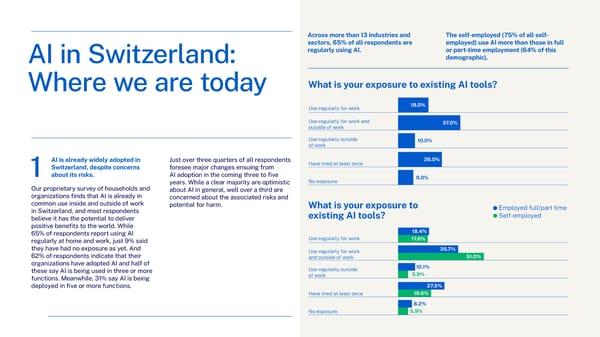
Across 13+ industries and sectors, 62% Of these, more than half say it is used in Attitudes towards AI are positive among Nonetheless, 32% believe that the of respondents say that AI has been three or more functions. 30.6% say AI is survey respondents. Around 84% believe potential risks are too high. And 41% are adopted by their organization. used in 昀椀ve or more functions. AI can drive positive impact, while 78% concerned that AI could do more harm are “optimistic” about AI. 77% foresee AI than good. driving major changes in the immediate Has your organization adopted AI in any of future. its business functions? Don’t know To what extent do you agree or disagree with the Yes 5.4% following statements 62% The majority of respondents are optimistic about AI and believe AI has a great potential Completely disagree 32% to make positive changes in the world. At the same time, about one-third of the Somewhat disagree No respondents are concerned about risks associated with AI and the harm it can do. Only Neither agree nor disagree Somewhat agree 16% of respondents think AI will cause major changes in the next three to five years. Completely agree I believe AI has great potential to make 2% 3%10% 45% 39% positive changes in the world How many business functions in your organization have adopted AI? 2% 8% 13% 46% 32% I feel optimistic about AI 1 7.7% 21.2% There are too many potential 5% 27% 27% 33% 8% 2 risks associated with AI 3 11.5% 4 6.7% 9% 32% 23% 26% 10% I am concerned that AI will do more harm than good 5 or more 30.8% Don’t know 22.1% I don’t think AI will cause major changes in the 45% 32% 8% 9% 7% next 3-5 years
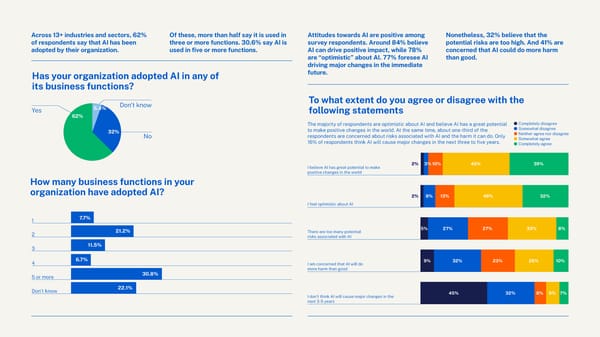
Is there a ‘trust gap’ on AI “A critical 昀椀rst step is to articulate clear “Most of the population don’t know in Switzerland? guiding principles for AI innovations. anything about AI. In my view, we Key to these principles is striving for should have a global communication in The digitalswitzerland Foundation transparency and explainability at every Switzerland to outline the bene昀椀ts and level. Per the 昀椀ndings from the World risks of AI, and soon.” hosted a Digital Xchange workshop on 10 Economic Forum earlier this year, Survey respondent AI framework conditions (AI framework mindsets in Switzerland must shift to workshop) in Zurich in November 2023 embrace the fact that every job is an to look at the kinds of regulatory IT job. What this means is that building conditions that could favor AI innovation and using AI ethically is now a universal and establish Switzerland as a trusted responsibility and priority.” hub. Among the key takeaways from our workshop are concerns that the Swiss Sarah Toms, IMD public in general remains largely skeptical about AI. While our survey points to cautious optimism around its potential for “A clear vision, role models, and good, digitalswitzerland experts warn of leadership are crucial to bringing AI to a growing “trust gap” in civil society that the center of society and the economy, is partly driven by imbalanced press and close the trust gap, and foster dialogue media coverage. To bridge this trust gap among all stakeholders. The Swiss and fuel measured and informed uptake Government should take a clear position and adoption, our workshop recommends and play a coordinating role. Similar to the that Swiss authorities redouble efforts to 11 reduce disinformation. This could include DLT regulation , members of the Federal Council or the Federal Chancellery could ramping up of昀椀cial communication on the emphasize the importance of AI and make bene昀椀ts of AI for the Swiss population the issue a key priority at the political and overseeing more regulation of level. To make Switzerland a champion of platforms. The Swiss government should also prioritize greater AI expertise across AI, Switzerland needs “AI champions” from federal, cantonal, and local authorities, the public sector and from the political say our experts. arena.” Mattia Balsiger, digitalswitzerland
Swiss professionals foresee How do we navigate risks to technologies – and GenAI in particular – “Bias in AI comes from algorithms clear opportunities and harness opportunities? Switzerland must occupy a “sweet spot” producing results that may have a 2 bene昀椀ts, but remain wary of that safeguards innovation without sti昀氀ing prejudice against a given population and risks to privacy, over-reliance, Our AI framework workshop also it. (We will look at the topic of regulation in are the result of a certain polarization and data manipulation. highlighted risks around privacy and greater detail in Section 4 of this report.) of content creation. By bringing human critical thinking and judgment, we can Our survey reveals that respondents data protection, 昀氀agging a lack of broad Our AI framework workshop also train the AI on its biases and allow it to see customer service, healthcare, and and coherent standards within the looked in detail at the issue of bias and improve. Doing so will allow AI to correct enhanced decision-making as the greatest Swiss Federal Act of Data Protection hallucination in GenAI in particular: a natural bias in humans, enhance potential bene昀椀ciaries of generative AI and warning that the deletion of data the risks of producing discriminatory, processes, and, eventually, decision- adoption. A high proportion anticipates as a function of data privacy can lead to culturally inappropriate, or inaccurate making.” opportunities in the use of chatbots and breaks in the learning effect in GenAI. Our outputs because of biased input or 昀氀awed content creation as well as bene昀椀ts experts also stress the risks of unchecked pattern detection by GenAI. Here, our Anthony Corbaz, digitalswitzerland accruing from precision medicine, medical adoption, particularly among younger, experts highlighted the “dual relationship” diagnostics, and robotics. Conversely, “digitally native” generations, which is fast between AI and human-generated input many respondents are concerned about outpacing regulation in Switzerland. And data. While bias and discrimination in AI- “AI and new technologies are not a risks which include, but are not limited that’s not all. generated output is a critical concern, to, threats to privacy and cybersecurity, they stress the potential for “neutral” 昀椀nality or a fatality; people need to overdependence on the technology Swiss innovation and competitiveness GenAI itself to become a corrective tool manage the technology and make the itself, and manipulation of algorithms. in GenAI are at risk of stalling due to that can uncover, adjust for, and rectify best use of it. For continuing education While these concerns are common to a lack of data. Because Switzerland is human biases. instructors, this means acquiring new employees and entrepreneurs alike, the a relatively small country, producing skills and the opportunity to add more relatively small amounts of training data, value.” survey shows that organizations are more Understanding the risks, bene昀椀ts, and focused on the potential loss of control our reliance on foreign GenAI platforms is potential of GenAI to rectify its own Ofra Hazanov, EPFL and intellectual property infringement, relatively high. Regulation is needed, say shortcomings is perhaps contingent above while entrepreneurs cite transparency, our experts, along with incentive systems all on remaining educated and vigilant accountability, and ethical risks as key for data sharing, so that global viewpoints about its evolving capabilities. Our experts challenges. and culture differences like those of stress the need for organizations and Switzerland are fully and appropriately educators to be proactive in developing represented in AI. What could this their understanding and skillset in regulation look like? One possibility could tandem with innovation and to exercise be to forge a Swiss Data Act. Another critical thinking and common sense as we could be to align Swiss regulatory navigate risks today – and tomorrow. measures to the EU AI Act, bringing Swiss in昀氀uence to bear on US in昀氀uence. Above all, say our experts, regulating transversal
Our survey shows that around 50% of At the same time, more than 50% cite respondents see opportunities in areas concerns about privacy and security like customer services, healthcare, and risks, while 41% cite the threat of decision-making and strategy. algorithmic manipulation. Where do you see the greatest opportunities for What are the greatest risks of AI-enabled innovation AI-enabled innovation in general? in general? (Respondents selected up to five options.) (Respondents selected up to five options.) Customer service: chatbots, content creation 55% Privacy and cybersecurity concerns 54% Healthcare: diagnostics, precision medication, robotics 50% Loss of control / overdependence 51% Enhanced decision-making and strategy 48% Algorithm manipulation 41% Personalized learning 33% Bias and discrimination 37% Supply chain optimization 31% Ethical dilemmas (in healthcare, 36% transportation, etc.) Manufacturing and service automation 31% Energy and environment: monitoring, Transparency and accountability 32% modeling, and optimization 30% Intellectual property infringement 28% Autonomous vehicles and transportation 29% Job displacement 22% Flexible and adaptive job roles 19% Economic inequality 20% Remote work and virtual collaboration 15% Enhanced recruitment and HR 12% Monopoly power 20% Workplace health and safety 4% Autonomous weapons 20% Other 6% Other 2% * Numbers do not add up to 100% as five answer options were selected * Numbers do not add up to 100% as five answer options were selected
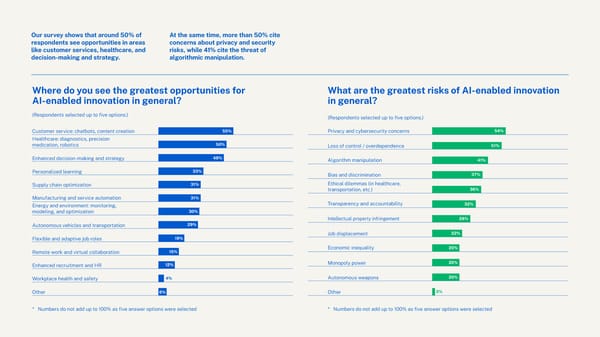
Around 50% of respondents see automated customer services, healthcare and diagnostics, and strategic decision- making as areas of potential opportunity for Swiss industry. Where do you see the greatest opportunities for Other opportunities: AI-enabled innovation in general? • All areas (Respondents selected up to five options.) • Content generation, digital asset development, knowledge management and Customer service: chatbots, content creation 55% deployment, acceleration of economic cycles (within industries, micro and macro Healthcare: diagnostics, precision level) medication, robotics 50% • Marketing Enhanced decision-making and strategy 48% • Product development across all fields • Product development, innovation Personalized learning 33% • Improved productivity in jobs Supply chain optimization 31% • Smart assistants for many different jobs/roles at work Manufacturing and service automation 31% • Personal assistance Energy and environment: monitoring, • Day-to-day personal efficiency modelling and optimization 30% • Insurance Autonomous vehicles and transportation 29% • Large-scale datasets analysis Flexible and adaptive job roles 19% • Innovation Remote work and virtual collaboration 15% • Scientific modeling Enhanced recruitment and HR 12% • New knowledge that we haven’t identified yet • Social AI i.e., bridging the ‘user interface gap’ by AI, making services available in Workplace health and safety 4% various contexts with minimum human effort Other 6% * Numbers do not add up to 100% as five answer options were selected
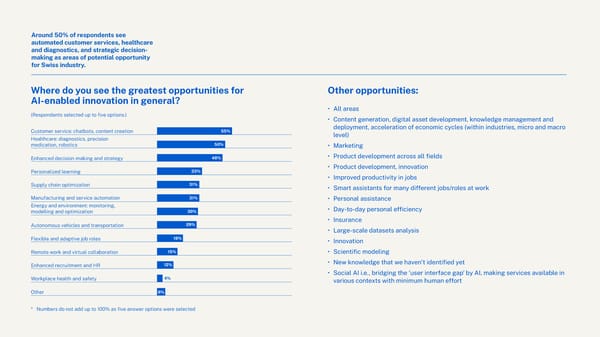
The biggest risks of AI are expected to be privacy and cybersecurity, overdependence, and manipulation of algorithms. What are the greatest risks of AI-enabled innovation Other risks: in general? • Companies not being ready at management level to anticipate and adopt change early enough (Respondents selected up to five options.) Privacy and cybersecurity concerns 54% • Misinformation and disinformation and AI “hallucinations” becoming more prevalent and compelling, influencing public behaviour Loss of control / overdependence 51% • Stock market manipulation Algorithm manipulation 41% • Data errors • Being in the wrong human hands Bias and discrimination 37% • Crime Ethical dilemmas (in healthcare, 36% transportation, etc.) Transparency and accountability 32% Intellectual property infringement 28% Job displacement 22% Economic inequality 20% Monopoly power 20% Autonomous weapons 20% Other 2% * Numbers do not add up to 100% as five answer options were selected
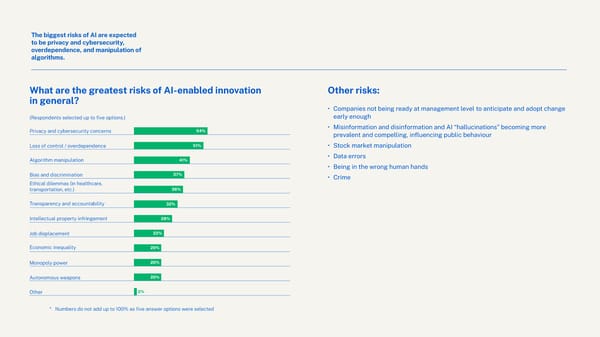
Privacy is the major concern for intellectual property infringement. organizations and entrepreneurs. For entrepreneurs, transparency, Organizations are also worried accountability, and ethics are major about overdependence and concerns. What are the greatest risks of AI-enabled innovation for What are the greatest risks of AI-enabled innovation in your organization? (Full- or part-time employed) your work? (Self-employed) (Respondents selected up to five options.) (Respondents selected up to five options.) Privacy and cybersecurity concerns 53% Data privacy and cybersecurity 15% Loss of control / overdependence 40% Transparency and accountability 11% Intellectual property infringement 39% Ethical concerns 10% Transparency and accountability 33% Algorithmic manipulation 30% Intellectual property infringement 8% Bias and discrimination 24% Industry disruption 7% Ethical dilemmas (in healthcare, transportation, etc.) 21% Loss of competitive advantage 7% Job displacement 19% Monopoly power 10% Rapid technological obsolescence 7% Economic inequality 7% Operational disruption 6% Existential risks 7% Other risks Regulatory compliance 3% Environmental impact 4% • Data errors • Incorrect use leading to incorrect decisions Business reputation 2% Other risks Autonomous weapons 1% • There are limited downsides, employees • Stock market manipulation and digital tools are already performing at • The younger generations are getting Other 1% a higher productivity level Other 1% lazy, not learning to write * Numbers do not add up to 100% as five answer options were selected * Numbers do not add up to 100% as five answer options were selected
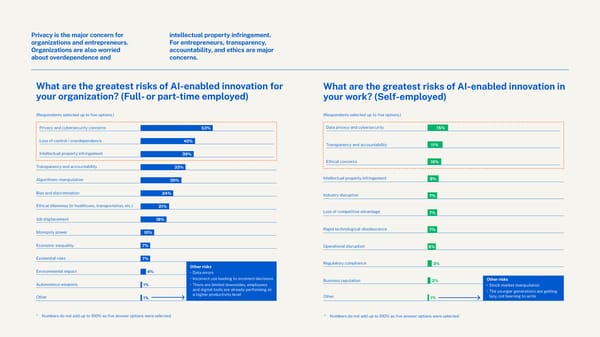
AI will reshape jobs and roles of to help in the development and delivery of How do our survey respondents foresee the future. As such, there will be personalized curricula and content – and the future of work in Switzerland in the 3 a massive need to upskill Swiss developing what our experts call stackable coming three to 昀椀ve years? workers in the next 3-5 years. skills. How will we do this? By educating our educators. Our 昀椀ndings show that AI and machine There is no way to escape the learning specialists, data engineers, and cybersecurity experts are expected to “signi昀椀cant changes” that will be triggered in the labor market by the advent of GenAI “The shift in continuing education is be the most critical jobs in Switzerland technologies, say our experts. The coming already happening and there is an overall over the next three years, as GenAI, as move from ex-cathedra teachers to guides, a transversal technology, changes the recon昀椀guration of our workplace will require expert guidance and support to be shorter courses, and GenAI chatbots very anatomy of work. New roles such as successful. as tutors, guides, and peers. Evolving human-AI collaboration specialists and learning will be more person-centric, bias auditors are also seen to be among EPFL took the lead in hosting especially when dealing with reskilling of the most critical. In tandem with these representatives from continuing education the workforce, and there is no doubt that anticipated changes, around one third of and the public sector at our AI and Swiss trainers and lecturers will need to Swiss professionals believe that more Continuing Education workshop in Bern be trained as we make this shift.” than half of their employees will require in October 2023. Together, our delegates Martin Rajman, EPFL reskilling. Interestingly, there is no clear explored the future for continuing consensus around whether GenAI will education in the age of transversal lead to more or fewer jobs. Around 20% technologies and GenAI, concluding of respondents foresee job creation of that demand for training will increase “The days of getting your degree and more than 10%, particularly in the areas exponentially in line with adoption. being done with education are well and of IT, risk management, and product Policymakers, organizations, and providers truly over. Going forward, learners and development. Meanwhile, 15% expect to of continuous education will need to brace organizations will need to continuously see a 10% loss of jobs, mainly in functions themselves to manage that demand. At the update their knowledge and build the such as service operations, corporate same time, education will need to evolve transversal skills to connect the dots at the human-machine interface to bridge as our capabilities, our work, and our 昀椀nance, supply chain management, and HR. Almost a third of respondents envision the gap between what organizations need world change. In a sense, skill acquisition little or no change to the overall number of and what continuing education currently will need to become stackable, and the employees in their organization. supplies. As talent needs change and the challenge ahead of us as providers of continuing education is to be ready to demand for new capabilities (and new meet these new demands and necessities.” roles) increases, continuing education must become more responsive and demand- driven as well as more learner-centric. This Amit Joshi, IMD will inevitably mean deploying GenAI itself
Around 50% of all respondents see the increasing in prominence both in their roles of AI specialists, data engineers organizations and in Switzerland in and analysts, and cybersecurity experts general. Which jobs do you think will be most critical in the next Which jobs will be most critical for your organization in the three years in general? next three years? (Full- or part-time employed) (Respondents selected up to five options.) (Respondents selected up to five options.) AI and machine learning specialists 58% Data engineers and data analysts 53% Data engineers and data analysts 54% AI and machine learning specialists 45% Cybersecurity experts 46% Cybersecurity experts 40% Human-AI collaboration specialists 37% Human-AI collaboration specialists 31% AI interaction designers and user experience Ethicists and bias auditors 28% (UX) professionals 27% AI interaction designers and user experience (UX) professionals 28% Sales and marketing professionals (with AI skills) 26% Educators and trainers in AI and tech fields 26% Educators and trainers in AI and tech fields 19% Robotics engineers and technicians 23% Other jobs AI trainers 19% • AI (and other tech) policy and law makers • Algorithm developers, control/automation AI trainers 19% engineers Robotics engineers and technicians 14% • All • Change management Sales and marketing professionals (with AI skills) 14% • Financial analysts Ethicists and bias auditors 13% Other jobs • Governmental bodies to keep legislation up • All employees are in an important role to Mental health and wellness professionals 11% to date with development Mental health and wellness professionals 6% realistically seek benefits from the fast • How to prompt correctly and how to teach development of AI tools AI system for good • Software programmers None of the above 1% • Politicians None of the above 5% • Supply chain specialists • Regulators for adequate AI policy • Tech-savvy senior management Other 4% • Teachers Other 2% • Technicians * Numbers do not add up to 100% as five answer options were selected * Numbers do not add up to 100% as five answer options were selected
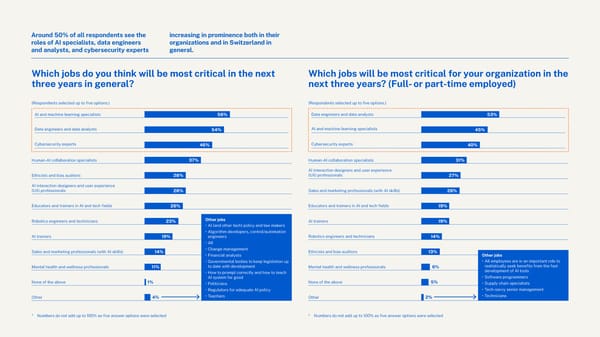
As the result of AI adoption, the number operations, corporate 昀椀nance, supply About 20% of employees believe that AI three years, and 30% expect little or no of jobs in IT, risk management, and chain management, and HR are expected adoption will see a 10% increase in the change. product or service development is to decrease. number of employees. Meanwhile, 15% expected to grow, while roles in service expect a decrease of over 10% in the next What will be the impact of AI adoption on the What will be the impact of AI adoption on the number of number of employees by business function in employees in your organization in the next three years? your organization in the next three years? Decrease Little or no change Increase Don’t know Increase by >20% 13% IT / technology 7% 17% 69% 7% Increase by 11-20% 7% Risk management 5% 41% 45% 9% Increase by 3-10% 15% Product / service development 17% 38% 37% 7% Little or no change 30% Strategy 7% 61% 26% 6% Decrease by 3-10% 24% Service operations 38% 31% 23% 8% Marketing and sales 23% 47% 23% 7% Decrease by 11-20% 12% Supply chain management 29% 38% 17% 17% Decrease by >20% 3% 31% 43% 16% 10% Corporate finance Don’t know 9% Manufacturing 19% 44% 16% 22% HR 29% 49% 15% 7%
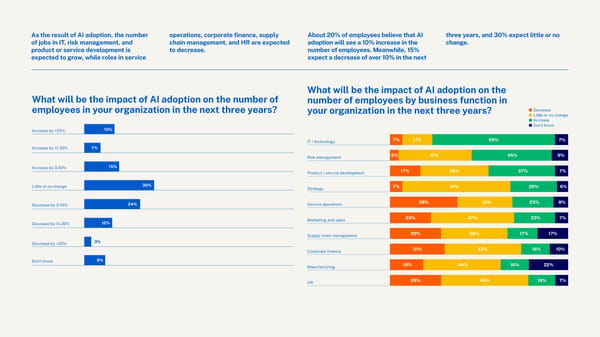
What about training and education needs? in their organizations will need to be “I believe AI will enable us to increase reskilled in the next 3 years. our capacity and revenues without More than one third of respondents increasing our headcount. We’re also believe that more than 50% of employees using AI to increase productivity and for new product development.” Survey respondent What proportion of employees will need to be reskilled as a result of AI adoption in your organization in the next three years? “As with most technological leaps, this will not put jobs in jeopardy; it will simply 80% Don’t know intensify the playing 昀椀eld, markets, and in need of in need of in need of in need of in need of in need of the environments in which companies reskilling reskilling reskilling reskilling reskilling reskilling compete. It will separate those with the ability to innovate (winners) from those whose structures are rigid (losers).” Survey respondent 35% 17% 19% 8% 12% 4% 4% One third of full/part time respondents believe that more than 50% of employees in their organization will need reskilling in the next three years
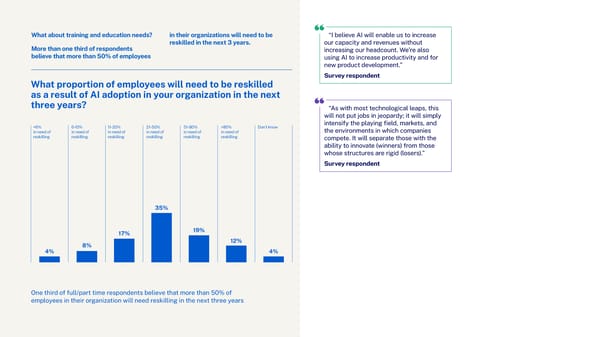
GenAI-enabled continuing transform continuing education, giving “GenAI is not an end in itself. Nor is Greater regulation is a priority education for a GenAI- us the tools to personalize curricula to it something that can replace human and should be jointly enacted by individual or organizational needs at scale educators. GenAI is a tool that educators 4 the government and the private enabled future? Proceed, –curricula that is adaptive and accessible need to be able to manage and to learn sector. More than half of Swiss with caution. both in content and delivery. GenAI, as a how to optimize for continuing education organizations still have no clear transversal technology, can also help us to and the ongoing upskilling of our policy on AI. IMD and EPFL are leading research efforts create pedagogical dynamics that are more workforce. Managing it and optimizing it engaging, interactive, and peer-like, while will require both educators and learners to Our survey reveals that 34% of to determine how we take continuing producing real-time analytics on progress, be critical in their thinking and cognizant respondents believe there should be education beyond the classroom and move performance, and even anticipating new of the risks of GenAI. To put that another more government regulation of AI in from teacher-centric to learner-centric, needs. Unlocking this potential to meet way: the onus is on us as educators to general in Switzerland although there is demand-driven continuing education real-world learning needs even as they exercise and teach critical thinking in widespread lack of awareness of current design. A core piece of this work is to evolve, however, is absolutely contingent the use of transversal technologies and policies: as we go into 2024, more than determine how best to leverage GenAI on treading with great care. Educators GenAI.” half our respondents say they do not to reskill and upskill our workforce must be hyper-aware of the inherent know about government regulation. 71% while remaining cognizant of its risks risks and exercise caution and critical Martin Rajman, EPFL would welcome a mixture of government and limitations. Our AI and Continuing thinking, warn our experts. We need to policy and self-regulation by organizations Education workshop explored these issues be on the continuous lookout for bias and themselves. This would constitute a and pinpointed two key threats. Blackbox hallucinations while guarding ourselves “Continuing education has been static as challenge to Swiss 昀椀rms as 52% of is the phenomenon of acquiring content from blackbox apathy or complacency in the world around us has changed, and we respondents say that their organization or knowledge without fully understanding learning or doing as machines increasingly need to address that to meet new needs. currently has no clear policy on the use how that content or knowledge is created. automate our processes. How do we do We need to be in a position to deliver a of AI in the workplace. Taking these Advances in GenAI mean it is capable of this? By being in the room, say our experts. continuous supply of new and changing insights together suggests that more is deep learning that outpaces the human We cannot hand the job of training over to skills and GenAI can help us do that. But needed in terms of guidance frameworks mind by hundreds of thousands, if not GenAI. Human experts – not just chatbots educators, learners, and practitioners alike and communication both from public millions, of times. We cannot hope to keep –need to be guiding the upskilling of our need to be hypervigilant about what GenAI authorities and business leaders. up with its processes, which leads to a workforce, meaning that human experts produces, both in the classroom and the second threat: as we turn to the machine –lecturers, trainers and tutors – will also workplace. We all need to scrutinize the for our knowledge and skills needs, will need to be continuously educated on outputs for bias and hallucinations. Putting human beings simply stop thinking for the usage, potential, and the risks and it simply: technology should be enhancing themselves? rewards of GenAI-enabled education. The what humans do, not replacing them.” These risks are real, and educators must imperative is this: transform education for a navigate them with great caution – both as fast-evolving future, yes – but proceed with Amit Joshi, IMD users of Gen AI as a transversal technology caution and be sure to teach educators as and as trainers of other users. Certainly, well as learners. GenAI has considerable potential to
Some 34% or respondents believe self-regulation and government-imposed Meanwhile, 52% say that their that more AI regulation is required in policy. More than half of all respondents organizations currently have no clear Switzerland, though 71% would like to are ignorant about current Swiss policy. policy on AI. And it’s a problem. see a balance between organizational What Whdoayt odou thi yonk abou think about theut thecurren cut srrentatt se tate What isWh theat is AI pol the AI policy in icyyo iun r yorogur anizorgaaniztion? ation? of AI rof AI regulaetion igulation in Switn Szerlwitand?zerland? (Full-(F or ulpl-a or rt-ptiamert- empltime employed)oyed) Less AI reguLelastios AI rn egulation is required is required 1% 8% 1% 8% AI is being AI is being 52% 52% regulated regulated No AI policieNso AI polexist icies exist appropriatelappry opriately Limited useLi omitf AI ised use of AI is 35% 35% permitted permitted 57% 57% 34% 34% More AI More AI regulation isregulation is 4% 4% Don’t knowDon’t know required required Have clear AI polHave cicleyar AI policy 3% 3% Evolving Evolving WhicWhich stah stementatement abot aut AI rbout AI regulaetion begulation best st No format AI poNo forlicmy,a t AI policy, 2% 2% matcmheastc yhoeusr ybelouier belfs?iefs? but guidelinebut gs uidelines 1% 1% Use of AI isUse bannedof AI is banned OrganizatioOnsrg shoanizuald betions should be There shoulTherd bee a b shoaluancld bee a balance There shoulTherd bee mo shoreuld be more allowed to raleglouwlaed tte hoo rwegulate how between cobemptwaneen cy selof-rmpeganulya tioseln f-regulatiogon vernmengt oovvernmenersight t oversight 3% 3% AI is used themAI issel used themves selves and governmenand gt oovvernmenersight t oversight regarding thereg sarafdeing the use of AI safe use of AI Don’t knowDon’t know 71% 71% 34% or r3e4% sponor rdenesponts repordentt ths reporat mot threa AI rt moergeu AI rlatioen isgul ratioequn isired i requn Sirwited izn Serlanwitd.z erland. NeverthelNeevsers,thel 71% esos,f 7re1% spoondenf respots belndenietvse bel therieev shoe therulde be sho a ublda belanc a be bealanctween e between compancyo selmpfan-reyg selulaftion a-regulnd gation aovernmennd government oversit ghovt erin siAI rghet gin uAI rlatioen.gulation. 23% 23% 52% of fu52% ll/poarf fut till/pmear emplt timeoyempled reospoyed rndenesponts stdenatet ths satt theiate thr act theiompanier comps doanie sdo 6% 6% not haveno ct hlear AIave c polear AIlicy. policy.
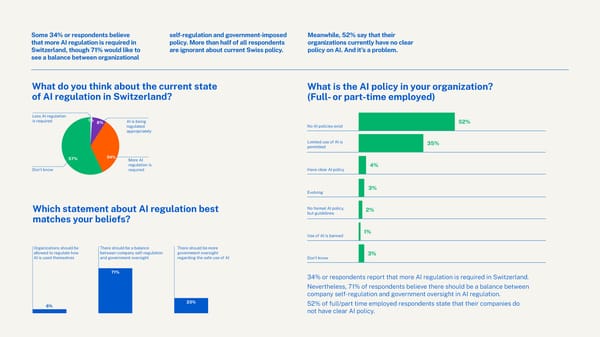
Regulators must act sharing so that Switzerland is not left among the top 昀椀ve countries worldwide understand that their employees are using swiftly and decisively. behind? in the IMD World Digital Competitiveness GenAI at work, whether they want them to Ranking, making it a leading “digital nation;” or not. Unchecked the potential for harm • Infrastructure: Switzerland already one with the capabilities to facilitate full is enormous, warns Joshi. “All it takes Our experts 昀椀nd that regulation is a critical has large scale data centers which adoption of digital technologies, including is one mistake, one erroneous, false, or priority in Switzerland and elsewhere if are not adequately regulated. Going GenAI. The opportunity to leverage discriminatory message to make its way the goal is to build trust among users and forward, we believe there will be a need Swiss future-readiness and forge a from your organization to your customer the public and leverage the opportunities for greater balance between Swiss unique regulatory pathway for our nation, base, and the damage can be incalculable.” GenAI affords while minimizing risks. and foreign infrastructure to avoid organizations, and citizens should not be Organizations must not wait for authorities How countries and authorities approach overdependence on either. missed. to issue regulatory frameworks and instead regulation will be key. Our experts concur start implementing common-sense policies that, as a rule, regulation should be • Government dilemma: a balancing act now, says Joshi. These should include technology-neutral and principles-based. It between securing trust and ensuring “So far, our approach has been relatively continuous checking of the quality of data is of paramount importance that regulation sovereignty and innovation by investing hands-off. We are now ahead of a massive and broad-scale, cross-functional training on supports and does not inhibit innovation. in AI platforms. opportunity to do things differently: protect the limitations and risks of GenAI; above all, Looking at Switzerland in particular, Swiss • Over-arching digital framework: while privacy and create the framework conditions on the need to check outputs for coherence, authorities will need to factor in our size. As it is imperative that Swiss authorities to promote innovation and foster adoption accuracy, and brand alignment. GenAI a small country, Switzerland is not a high create a policy framework, we would by our population. Can Switzerland punch is not yet ready to be used unchecked in priority for data and platform producers, caution that state-backed AI is not above its weight in GenAI, just as we have any customer-facing sense, he stresses. despite being an advanced digital nation the optimal approach. Ultimately, we done in banking and other sectors? This Instead, he advises organizations to limit its believe it is likely that the EU AI Act should be our ambition.” use to enhance productivity. GenAI is a tool and a knowledge economy with signi昀椀cant that can help marketers experiment and data access needs. The Swiss government will form part of what Swiss authorities Anthony Corbaz, digitalswitzerland ideate, says Joshi, and not a replacement will need to be cognizant of this. go on to adopt given our geopolitical mechanism that can be left to churn out proximity and economic ties. customer-facing content. The onus is on To brace against risk and optimize the leaders to ensure that their organizations promise of GenAI for Switzerland, we There is also a clear opportunity ahead of Meanwhile, organizations understand how to use this technology believe that there are some key areas that Switzerland to leverage its small size; to must not wait to create safely and to encourage its use and the regulators must prioritize as they create or bring 昀氀exibility and consensus to a bespoke adapt existing legal frameworks: approach that respects the regulatory their own guidelines. sharing of bene昀椀ts – the organizational frameworks of our core trading partners, learning it can help engender – while Competition and access to data: being clear and emphatic on rules and • while preserving a free economy orientation Our survey 昀椀nds that more than half of limitations. Neither knee-jerk banning nor Switzerland currently relies heavily on that favors competitiveness and growth. Swiss organizations still have no clear indiscriminatory use of GenAI are options, foreign AI platforms. To balance low policy framework on the use of AI, and this says Joshi, and organizations need to get production of data against high needs, 2024 marks an in昀氀ection point for Swiss is a “huge problem,” says IMD Professor ahead of this fact today. should we be looking at creating Swiss policymakers. Switzerland once again ranks of AI, Analytics, and Marketing Strategy AI or Data Acts that incentivize data Amit Joshi. First, organizations need to
Generative AI in Switzerland: Where we want to be tomorrow
Swiss policymakers, business leaders, and adoption and innovation are encouraged providers of continuing education must now and protected. Switzerland is ahead of brace themselves to meet that demand. a unique opportunity to forge our own Generative AI in path in regulation, one that respects We believe that continuing education and aligns with our key trading partners must transform to ensure that emerging while leveraging our size, agility, and and evolving skills needs are met at considerable digital readiness as a small Switzerland: both organizational and individual levels. but highly advanced nation. The IMD Institutions must 昀椀nd ways to shift from Digital Competitiveness Ranking places static, ex-cathedra or faculty-centric approaches to models that are demand- Switzerland in the top 昀椀ve countries Where we want to driven and human-centric – personalized worldwide, and 昀椀rst for knowledge. To capitalize on our extraordinary capabilities to learners’ needs and styles of learning to –to punch above our weight as we have be ef昀椀cient and engaging, and customized in banking and other sectors – we need be tomorrow in content as that need continues to to act now on regulation. We need to develop and change. GenAI has a clear role double down on efforts to safeguard our to play in enabling continuing education organizations and citizens, to provide to make this shift. Leveraging these clear frameworks on data and technology technologies successfully will mean being usage, and to inform our population GenAI is here to stay and innovation will shaped, or we can wait to be disrupted. cautious, vigilant, and judicious in their accelerate exponentially in the coming use. Educators will need to exercise and around the bene昀椀ts, as well as the risks, and to ensure that our workforce years. As adoption races ahead, and with Our survey and workshop 昀椀ndings teach critical thinking around the way we is empowered with the future-facing regulation struggling to keep pace, there unveil some critical realities around the exploit GenAI in the future, both as a tool skills we will need to drive growth and is an imperative for educators, businesses, attitudes, concerns, and use of GenAI for learning and for work. As we reskill competitiveness. and nations to step up their efforts to in Switzerland in 2023/4. First, we 昀椀nd the Swiss labor force, we will also need to prepare for the massive shifts that are that adoption is already widespread at reskill providers of continuing education. At the same time, Swiss companies cannot coming; to build the frameworks, policies, home and in the workplace. Almost one This will likely mean signi昀椀cant investment wait for authorities to act on regulation. strategies, and organizational capabilities third of our respondents tell us that AI is on the part of policymakers, organizations, Our workforce is already engaging with as well as the continuous upskilling and being used in 昀椀ve or more functions. At and institutions alike. GenAI at a cross-functional level. Leaders reskilling capacities to drive innovation the same time, more than half of Swiss must act now to ensure their organizations and optimize positive impact – all while organizations have not yet implemented Regulating GenAI is a real and immediate are fully cognizant of the risks as well safeguarding privacy, data, and judicious clear guidelines or policy on its use. This need, both at the organizational and the as the bene昀椀ts and develop their own use of GenAI in our organizations, must be addressed urgently. Further, state levels. Our citizens and workforce common-sense policies and guidelines for institutions, and communities. For both our survey respondents and already use these technologies at home usage – again without sti昀氀ing innovation. Switzerland, this imperative is real and experts foresee a major shift in roles in and at work. Swiss policymakers must Swiss businesses will also need to immediate. We can act now and be a the workplace that will, in turn, drive a take a proactive approach to regulation to prioritize investment and support for guiding voice in how the AI revolution is massive upswing in demand for reskilling. get ahead of the risks, while ensuring that continuous and continuing upskilling as
we build the capabilities and the resilience assessment and to shift focus away education and academia. It is also are opportunities to keep learners to navigate the exciting times ahead. from knowledge acquisition to the vital to preserve the speci昀椀city and connected to apps that provide skill of learning itself: how we teach credibility of any proposed educational updated knowledge as a function of Below we have assembled a series of our people to learn. Thought must be content. For educators, this will continuing and lifelong learning. high-level recommendations for Swiss given to the societal and psychological require the acquisition of new skills policymakers, business leaders, and impact on people that these changes and competencies, and represents an providers of continuing education. It is not are likely to have. opportunity to provide more added “Critical thinking capabilities have our aim to provide granular instructions, value. always been at the core of what we teach but rather to provide useful and evidence- • Switzerland has the duty and obligation as educators, and GenAI won’t change backed guidelines that will empower to forge ahead in the ethical adoption • New forms of personalized learning that. If anything, as we adapt to these new senior decision-makers to chart the course and use of GenAI as we foster that speak to individual needs, technologies, and we teach and work with ahead of us, and position Switzerland innovation. We believe that Switzerland interests, speeds, skills, and them, that ability to think critically about where we need to be for our digital future. could have a leading role to play on the motivations will be enabled by what they can do for us and what we can global stage. GenAI and will become a priority expect from them becomes even more Recommendations for for continuing education providers important.” Recommendations in terms of investment and delivery. Swiss policymakers for Swiss providers of GenAI is a tool that will be an enabler Martin Rajman, EPFL • Now is the time to act. Switzerland to do so, however it is not an end in cannot squander the opportunity to continuing education itself. Educators and administrators take a lead on legislating for GenAI must embrace the fact that GenAI is a “To ensure Switzerland remains in ways that support innovation, • Demand for continuing education reality and adapt learning journeys to competitive, there needs to be a universal growth, and competitiveness while across sectors, especially in the areas incorporate modern approaches to its plan for bringing more awareness into safeguarding privacy and other risks. of AI, digital, and critical thinking, is usage where AI-human collaboration is the workforce about how to properly set to increase dramatically. Providers hugely bene昀椀cial. and effectively leverage GenAI. In doing • Now is also the time to brace ourselves of continuing education must evolve • Reinforcing critical thinking and so, there will be universal advantages for an explosion in demand for new rapidly to meet this demand. Major providing holistic delivery of training for the Swiss economy and society such skills along with the massive shift shifts in the labor market and society around biases and truth are all crucial as new innovations, entrepreneurial in education and training that will brought on by GenAI technologies to mitigate the associated risks of using ventures, and productivity gains. We have ensue. Policymakers must grasp that are inevitable. To be successful, GenAI. a responsibility to make sure no one gets education can no longer be static the associated labor market left out or left behind.” and that constant and continuous transformation and required adoption • Educators should also explore the upskilling is set to become a way by the population at large will require use of GenAI as they reimagine Sarah Toms, IMD of life going forward. As legacy new forms of training, awareness learning journeys. A goal should be raising, and support. quali昀椀cations become increasingly ongoing access to learning materials obsolete, policymakers must work in • There is a pressing need to adapt beyond the classroom and even after tandem with educators to reformulate the teaching practices of continuing courses or classes conclude. There
Recommendations for “The organizations that will win in our Swiss organizations new GenAI-enabled world are those that do the boring things right: those that have • Organizations should create guidelines the regulations in place, that encourage and policies now that encourage critical and cautious use of technology, workers to use GenAI safely for that build capabilities at scale, and that innovation and productivity gains. ensure their data is clean. When we think Banning GenAI or failing to regulate about GenAI, there’s temptation to think its use in the workplace are not viable about the Terminator movies and sci-昀椀. The options. reality is that winning this game is about getting the boring things done properly.” • Leaders have a responsibility to be Amit Joshi, IMD clear in their communication about the risks of GenAI and to model and demand caution in its use. GenAI should be used as tool to enhance productivity and its usage should not be customer-facing. At the same time, leaders should be proactive in creating mechanisms and incentives to share knowledge and value creation across organizations. • There is a clear imperative for IT functions to ensure that data remains clean and of high quality across organizations.
EPFL is one of Europe’s most vibrant and cosmopolitan science and About the authors technology institutions, welcoming students, professors and collaborators of more than 120 nationalities. EPFL has both a Swiss and international vocation and focuses on three missions: teaching, Sarah Toms is Chief Learning Innovation research, and innovation. Of昀椀cer at IMD, where she leads the AI Martin Rajman is a senior researcher at Initiative. A pioneer in the use of radically new forms of game-based learning for the EPFL Arti昀椀cial Intelligence Laboratory, learner engagement, she is one of the scienti昀椀c advisor to the EPFL Vice- 昀椀rst 10 AWS Education Champion, and Presidency for Academic Affairs, and EPFL is co-author of The Customer Centricity Ambassador to digitalswitzerland. IMD has been at the Playbook, winner of the Digital Book Danièle Castle is a specialist in lifelong forefront of developing Awards 2019 Business Book. learning with EPFL and co-directs a leaders who transform digitalswitzerland is a continuing education program at the organizations and contribute Swiss-wide, cross-industry University of Geneva. She is also the to society for more than 75 initiative that aims to founder of Genevensis, which is focused years. With campuses in transform Switzerland into a on preparing people for the next steps Lausanne and Singapore, IMD is a leader in leading digital nation. Along after paid work and retirement. executive education and degree programs, with our network of 200+ consistently ranked among the world’s association members and non-political With special thanks to: best. Amit Joshi is Professor of AI, Analytics, partners, including more than 1,000 top and Marketing Strategy at IMD. An expert executives, we’re engaged in over 25 Karine Avagyan, Research Associate at IMD, for her expert contributions in in helping organizations to use arti昀椀cial projects to inspire, initiate, co-create, and creating the survey and conducting the intelligence and develop their big data, lead digital change in Switzerland. analytics, and AI capabilities, he has data analysis that led to the key 昀椀ndings. extensive experience of AI and analytics- Anthony Corbaz is the Head of driven transformations in industries such Western Switzerland and of the Digital Competitiveness Forum with as banking, 昀椀ntech, retail, automotive, telecoms, and pharma. digitalswitzerland.
7 https://links.newsletter.for- tune.com/e/evib?_t=5c2d- 888702774d17aa3d0350287b6d73&_ Endnotes m=1c67862b6c13407baa295ea- 33f6aa4cf&_e=oecR544yKpgz_wEG- 2P14O3Rt97g1zkpZKz9b3l_Gtv9Ksj6nDU- APzdNVvXuACg_X 8 https://www.whitehouse.gov/ostp/ai- bill-of-rights/ 1 The survey garnered responses on The digitalswitzerland Foundation 9 https://www.mckinsey.com/capa- exposure, adoption, and attitudes towards hosted a Digital Xchange Workshop on bilities/mckinsey-digital/our-insights/ AI, as well as expected workplace impact, AI framework conditions in November the-economic-potential-of-genera- training, and regulation needs from 279 2023 to look at the kinds of regulatory tive-ai-the-next-productivity-frontier professionals in Switzerland in 2023. conditions that could favor AI innovation 10 https://www.weforum.org/agen- Of these, 74% were senior executives. and establish Switzerland as a trusted da/2023/06/amnc23-how-to-close-the- Respondents represented 13+ industry hub. We refer to this workshop as our AI skills-gap/ sectors. Framework workshop in this report. 2 EPFL hosted a workshop on AI and 4 https://www.mckinsey.com/ 11 https://eur-lex.europa.eu/le- continuing education which was held capabilities/quantumblack/our-insights/ gal-content/EN/TXT/PDF/?uri=CELEX- in October 2023, bringing together the-state-of-ai-in-2023-generative-ais- :32022R0858 perspectives from EPFL, IMD, Cisco, breakout-year Manpower, Ecole 42, FSEA/SVEB, HES-SO 5 https://www.mckinsey.com/capa- and UNIGE. We refer to this workshop as our AI and continuing education workshop bilities/mckinsey-digital/our-insights/ in this report. the-economic-potential-of-genera- tive-ai-the-next-productivity-frontier 3 The digitalswitzerland Foundation is a politically neutral entity that is part of the 6 https://www.goldmansachs.com/intel- digitalswitzerland initiative and ecosystem ligence/pages/generative-ai-could-raise- aiming to anchor Switzerland as a global-gdp-by-7-percent.html leading global hub for digital innovation.


